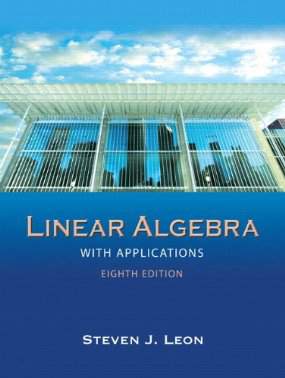Connecting...

This is a quick preview of the lesson. For full access, please Log In or Sign up.
For more information, please see full course syllabus of Linear Algebra
For more information, please see full course syllabus of Linear Algebra
Linear Algebra Matrices
Lecture Description
Matrices are a way of organizing numbers, and in using matrices there are certain rules one must follow. This video will serve as an introduction to what matrices are, and the rules, called operations, that you can do with them. This is not a topic that you can half-understand; matrices are to linear algebra as variables are to normal algebra. These are what this course will use in place of general numbers and variables a great deal of the time, so if you don’t have matrices down completely by the time you move on you will surely fall behind.
Bookmark & Share
Embed
Share this knowledge with your friends!
Copy & Paste this embed code into your website’s HTML
Please ensure that your website editor is in text mode when you paste the code.(In Wordpress, the mode button is on the top right corner.)
×
Since this lesson is not free, only the preview will appear on your website.
- - Allow users to view the embedded video in full-size.
Next Lecture
Previous Lecture










































 Answer Engine
Answer Engine




1 answer
Fri Dec 13, 2019 9:26 AM
Post by jinghuq1 on December 10, 2019
In the example session, it should be "24" instead of "-24"
1 answer
Fri Aug 3, 2018 11:25 PM
Post by Gore Fee on July 31, 2018
I love these lectures. Thanks
1 answer
Sat Oct 14, 2017 3:29 AM
Post by Levon Guyumjan on October 11, 2017
I truly enjoy your explanation, is detailed and very clear. Thank so much
2 answers
Last reply by: hajar maazia
Sat Jul 13, 2013 9:26 AM
Post by hajar maazia on July 12, 2013
hello ,
Please professor I would like to ask you about how to find DU of the matrices ? suppose i found U how can I get D ?
1 answer
Sun Jun 2, 2013 4:04 PM
Post by Manfred Berger on May 30, 2013
Is 'regular matrix' supposed to mean the opposite of singular here, or is this just a shape qualifier?
0 answers
Post by Maimouna Louche on June 20, 2012
I use to freeze whenever I see matrixes, thanks, you make it so easy.
I love educator! ^.^
1 answer
Sat Jul 14, 2012 9:06 PM
Post by Ahmad Alshammari on June 6, 2012
i would pay more than 35 dollars to reach your luctures professor :)
Thank you, and thank you Educator. Hopefully you will make a diff equations course.
0 answers
Post by Mohammed Altannak on March 3, 2012
That was Perfect
Thanks Professor =)
0 answers
Post by Real Schiran on February 29, 2012
Better than ever ! perfection ..
3 answers
Tue Jan 14, 2014 6:00 AM
Post by Ken Mullin on January 26, 2012
I believe there is an error in the section where Matrix B is recopied (see the elements in the Matrix B in the 2nd row --the original Matrix B has -8 in the 2nd row, 3d column.
The scalar -3 is being multiplied to a Matrix B that has a POSITIVE 8 (not negative, as in the original).
Performing the operation on my TI-84..the 2nd row, 3 column element is a POSITIVE 24 (-3 x -8 = +24).
In the end--the transposed matrix becomes:
-12 5
17 8
-8 26
Am I correct Professor?--Please advise
0 answers
Post by thomas kotch on December 23, 2011
Splendid!